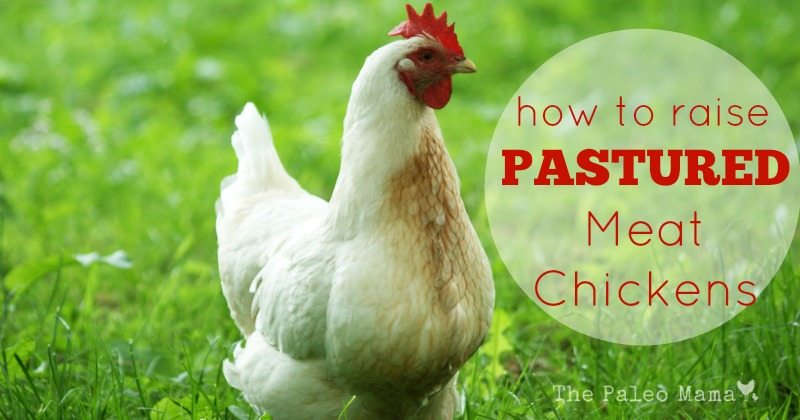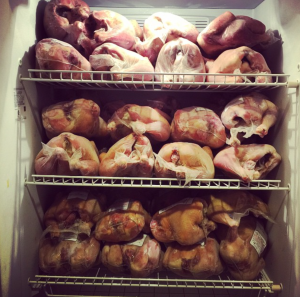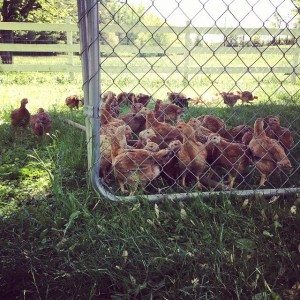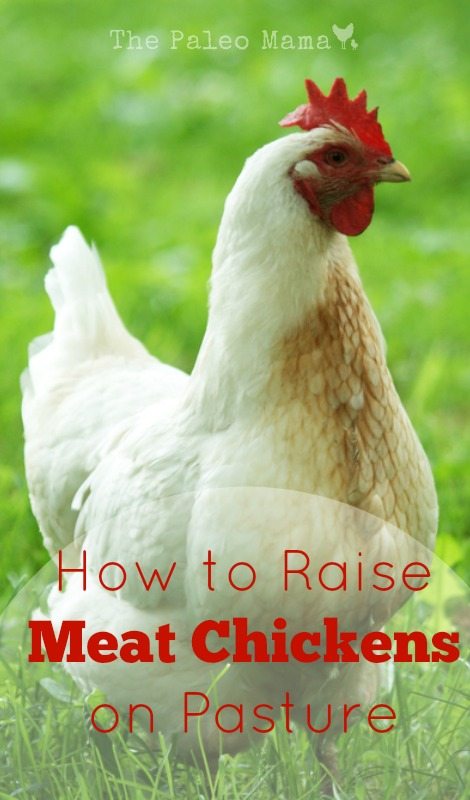

Just before we moved, we processed our a brood of meat chickens, and have 50 delicious frozen meat chickens (broilers) in our freezer, waiting for us to use. Some of you may remember going to “Grandma’s House” and having a tasty chicken dinner. Others, like me, have probably heard other people talking about the whole experience of raising—and butchering—chickens. Maybe you’ve even played with the detached chicken feet by pulling on the cut muscles and making those feet still “walk.”…maybe not!

Raising chickens today is very different than how it was done in the “old days.” The average supermarket chicken never sees the light of day, and may be only 4-5 weeks old when butchered. They are grown in very close quarters with thousands of other birds. Their beaks have been cut off so that the stress of being in uncomfortable living conditions doesn’t lead to pecking their fellows to death. Is it any wonder chicken and eggs today don’t taste like they used to?
It’s for these reasons, and because we want to be sure that the food we eat is as organic and free of pesticides and chemicals as possible that we raise both egg-laying hens and meat chickens. In this blog post we’ll take a look at how to raise meat chickens on pasture, called broilers in most instances. There are 5 steps we will investigate:
- Should you raise meat chickens?
- How do you raise baby chicks?
- What kind of coop should you choose?
- When do your baby chicks move outside?
- How do you go about processing your meat chickens?
1. Should you raise meat chickens?
It may seem so easy:
- Buy chicks
- Feed chicks
- Harvest and package
- Eat
But raising meat chickens is very different than raising pullets (egg-laying chickens). There is a greater cost, they require greater maintenance, they stink more, and it is physically, emotionally, and financially draining to do your own butchering. One chicken farmer shared the costs for raising 45 meat chickens from chick to chicken dinner. It was a whopping $1,404.35, or about $40 per bird. (Source) That’s a pretty expensive chicken dinner.
But although you need to consider all aspects of raising meat chickens before you start, I have no intention of trying to discourage you from doing it. We will do it again, and we hope you will see the value in it also. We estimated it cost us a little over $20 per bird and for us that is worth it. We know how each chicken lived it’s life, what it ate, and if it was ever sick.
Make sure you do your own research before you begin. Put a plan together that includes answers to these questions:
- Will you use a pen or day-range production system?
- How many birds will you raise the first year?
- Who will do the work?
- When do you want your first chicks to arrive?
- Who will process the broilers?
- Where will you market the birds, and what do you need to do to make that happen?
You will also need to decide what kind of meat chickens you will raise. The kind of meat chicken that is mass produced is the Cornish Rock Cross, which is a bird that grows so fast that sometimes its heart explodes and its legs give out because it can’t support its unnatural weight. Another slower growing chicken is Freedom Rangers, which is a hybrid breed (cross between commercial and a heritage breed) but has less problems than the Cornish Cross. You may even choose to stick with the older standard breeds like the Delaware or Barred Rock (also laying birds).
2. How do you raise baby chicks?
If you are lucky enough to have a hatchery close by, then you can simply go there to buy your chicks. But if you are like most people, the internet is your answer. We chose to raise a less “commercial” breed this year. This is a hybrid breed this year called Freedom Rangers (you can order them here) and a good alternative to those fast-growing Cornish X. When your chicks arrive in the mail, you will need to have your brooder, feed and water, and a way to keep them clean in order to keep them healthy. The equipment you will need includes:
Brooding Lamp—This is a 250 watt red light in a reflective housing that provides heat for the chicks, who have no feathers yet to keep them warm. The Brinsea EcoGlow Brooder for Chicks (Here) uses less power and is much safer than a traditional bulb.
Thermometer—The best ones to use are those used to watch food temperatures, which has a probe on a wire attached to a separate base.
Bedding—Paper towels work great for a few days because the chicks tend to want to eat the shavings. Place them on top of pine shavings and then switch to just the pine shavings, a few inches thick. Cedar is toxic to poultry. Make sure there are enough shavings to keep them dry. Put fresh shavings down each day or consider the deep litter method by adding fresh shavings to the top everyday.
Feeders and Waterers—You are probably feeding a number of chicks, and you don’t want them running out of feed or water. Something like the Little Giant 11 lbs Plastic Hanging Poultry Feeder (Here) will keep you from running out. You have a couple of choices for a waterer. Chicken Nipples (Here) are cheap and easy to hook up. Or you may want something movable like the 5 Gallon Chicken Waterer (Here). Just be sure to give the base a good rinse once in a while.
3. What kind of coop should you use?
There are a couple of different types and features to consider. A chicken coop with a run is a more permanent design. It includes a fenced-in area outside to run around, and a sheltered space inside the coop. You can find several different designs online. If you are able to completely free range your chickens, a wagon-type chicken tractor is the best method. It is a chicken coop on a trailer or wagon frame that you can move about with either a small tractor or an ATV. Your chickens will go in it at night and you can close it up to protect them from predators. In the morning you move them to a new spot, open the door and let them range and forage.
We used a chain link fence with a tarp roof as a coop this year. We would lock them up at night to keep them safe from predators and then open the coop door for them all day long. We had zero predator attacks, but that could be due to the fact we have a livestock guardian dog.
4. When do your baby chicks move outside?

When you see that your chicks have feathered out they are old enough to go outside. Give them 12 hours with feed, and 12 without. Most chicks forage more in the morning when they are moved to a new location, and will fill up on grass, which helps to cut feed costs. Your local feed store can help you decide on the right grain mix. If you are raising your birds chemical free, you will need to avoid medicated feeds and use alternatives (such as vinegar or garlic cloves in the water) to keep the chicks thriving. A broiler will eat 9-15 pounds of feed during its lifetime.
We held feed in the morning when they woke up hungry till about 10am. This forced them to forage and peck around the grass and bugs when we let them out. This isn’t necessary if you are unable to do this because of work schedules.
It will be critical to keep water in front of the birds at all times, especially in hot weather. Check the pens several times a day to be sure your waterers are working properly or purchase a very large waterer.
Losing a bird or two either to health issues or predators throughout their life span is normal for these chickens. Keep a close eye on them so you can spot any sick ones and isolate them from the others.
5. How do you go about processing your meat chickens?

Most broilers are ready to process at eight weeks of age, and will be four to six pounds processed weight. Our Freedom Rangers took about ten weeks and they all came out to 5-6 pounds finished! Our Cornish X’s that we raised 2 years ago took only 8 weeks.
Butchering your own chickens is not for the faint of heart. You first need to kill them quickly, dunk them in hot water, get their feathers off, gut them, and package them. An easier way is to take them to a processor or butcher shop. You will be eating this food, so do your research. Talk to them about costs and packaging. Most will vacuum seal the birds, at a cost per bird.
If you are planning on processing your own chickens for meat, you will find complete instructions for setting up your processing station and processing your birds here.
There is an emotional component to raising chickens. We raise them from babies, laugh at their antics and work hard to give them a good life with nutritious food and a comfortable home. Then it becomes time to kill them. We choose to treat all living things with reverence and thank them for providing food for us. That doesn’t mean that there’s not some sadness, but over-all, this works best for us.

Sources
- https://greenthumbfarming.com/raising-meat-chickens/
- https://stonybrookfarm.wordpress.com/farming-practices/farming-practices-meat-chickens-aka-broilers/
- https://ecofriendly.com/raising-meat-chickens/
- https://www.chickenthistlefarm.com/pasture-raised-chickens/
- https://www.motherearthnews.com/homesteading-and-livestock/raising-chickens-for-meat-zmaz09jjzraw.aspx
I wonder – how much space do you need per chicken to keep the pasture actually green?
It varies quite a bit…here’s a link to help you get the information you need.
https://www.avianaquamiser.com/posts/How_much_space_do_chickens_need_on_pasture__63__/
jackie, do you find that the birds eat much less “feed” if they’re allowed to free range most of the day? or is that how you came up with the 9-15 lbs of feed range? i was planning on ordering 100 freedom ranger chicks and there is a good place in my area to have them butchered. i’m ready to be done with chicks for a while! we will be borrowing a tractor/coop and will have 200 ft in portable fencing to move them around. thanks for your reply!
Chickens cannot get sufficient nutrition just from the pasture, and will always need additional feed. You can find several excellent websites that can help you understand the balance. Here is one excellent one to start: https://www.lionsgrip.com/pastured.html